Mammals radiated after the extinction of non-avian dinosaurs
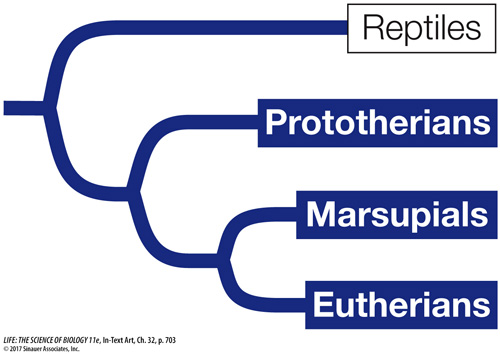
Small and medium-
Four key features distinguish the mammals:
Sweat glands, which secrete sweat that evaporates and thereby cools an animal
Mammary glands, which in females secrete a nutritive fluid (milk) on which newborn individuals feed
Hair, which provides a protective and insulating covering
A four-
chambered heart that completely separates the oxygenated blood coming from the lungs from the deoxygenated blood returning from the body (this last characteristic is convergent with the archosaurs, including modern birds and crocodiles)
Mammalian eggs are fertilized within the female’s body, and in nearly all mammalian groups the resulting embryos undergo a period of development inside the female’s body in an organ called the uterus. In the uterus, the embryo is contained in an amniotic sac that is homologous to one of the four membranes found in the amniote egg (see Figure 32.19). The embryo is connected to the wall of the uterus by an organ called a placenta. The placenta allows for nutrient and gas exchange, as well as waste elimination from the developing embryo, via the female’s circulatory system. Most mammals develop a covering of hair (fur), which is luxuriant in some species but has been greatly reduced in others, including cetaceans (whales and dolphins) and humans. Thick layers of insulating fat (blubber) replace hair as a heat-
The approximately 5,700 species of living mammals are divided into two primary groups: the prototherians and the therians (Table 32.1). Members of the therian clade are further divided into the marsupials and the eutherians.
| Group | Number of described species | Examples |
|---|---|---|
| PROTOTHERIANS | ||
| Monotremes (Monotremata) | 5 | Echidnas, duck- |
| THERIANS | ||
| Marsupials | ||
| Diprotodonts (Diprotodontia) | 146 | Kangaroos, wallabies, possums, koala, wombats |
| New World opossums (Didelphimorphia) | 93 | Opossums |
| Carnivorous marsupials (Dasyuromorphia) | 75 | Quolls, dunnarts, numbat, Tasmanian devil |
| Omnivorous marsupials (Peramelemorphia) | 24 | Bandicoots and bilbies |
| Shrew opossums (Paucituberculata) | 7 | Andean rat opossums |
| Marsupial moles (Notoryctemorphia) | 2 | Southern and northern marsupial moles |
| Microbiothere (Microbiotherea) | 1 | Monito del monte |
| Eutherians | ||
| Rodents (Rodentia) | 2,337 | Rats, mice, squirrels, woodchucks, ground squirrels, beaver, capybara |
| Bats (Chiroptera) | 1,171 | Fruit bats, echo- |
| Even- |
469 | Deer, sheep, goats, cattle, antelopes, giraffes, camels, swine, hippopotamus, whales, dolphins |
| Shrews, moles, and relatives (Soricomorpha) | 428 | Shrews, moles, solenodons |
| Primates (Primates) | 396 | Lemurs, monkeys, apes, humans |
| Carnivores (Carnivora) | 284 | Wolves, dogs, bears, cats, weasels, pinnipeds (seals, sea lions, walruses) |
| Rabbits and relatives (Lagomorpha) | 92 | Rabbits, hares, pikas |
| African insectivores (Afrosoricida) | 50 | Tenrecs, golden moles |
| Hedgehogs (Erinaceomorpha) | 24 | European hedgehog |
| Armadillos (Cingulata) | 21 | Giant armadillo, nine- |
| Tree shrews (Scandentia) | 20 | Pygmy tree shrew, pen- |
| Odd- |
16 | Horses, zebras, tapirs, rhinoceroses |
| Elephant shrews (Macroscelidea) | 15 | Elephant shrews, jumping shrews, sengis |
| Anteaters, sloths (Pilosa) | 10 | Anteaters, tamanduas, two- |
| Pangolins (Pholidota) | 8 | Asian and African pangolins |
| Hyraxes and relatives (Hyracoidea) | 5 | Hyraxes, dassies |
| Sirenians (Sirenia) | 4 | Manatees, dugongs |
| Elephants (Proboscidea) | 3 | African and Indian elephants |
| Colugos (Dermoptera) | 2 | Flying lemurs |
| Aardvark (Tubulidentata) | 1 | Aardvark |
PROTOTHERIANS Only five species of living prototherians are known, and they are found only in Australia and New Guinea. These mammals, the duck-
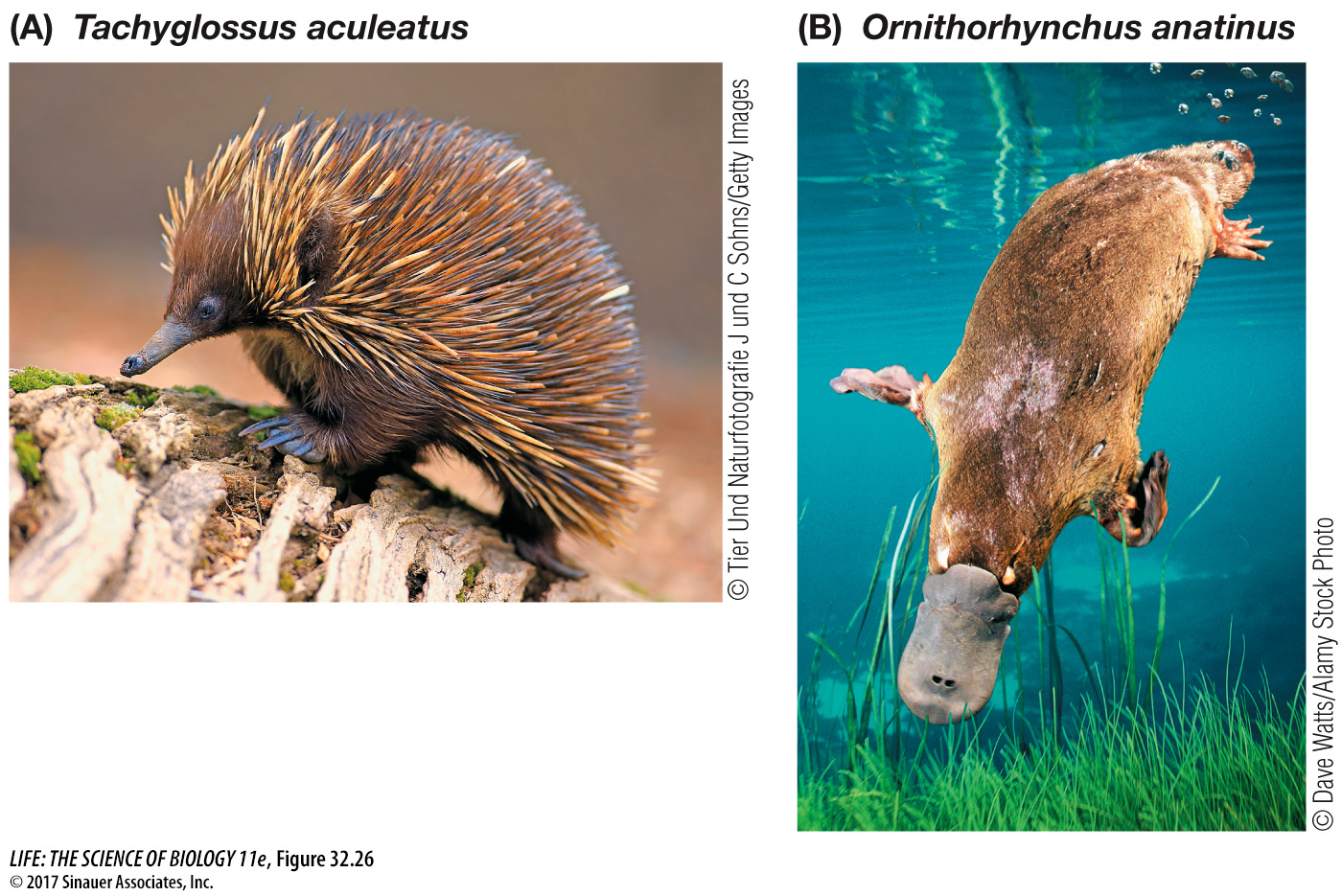
MARSUPIALS Females of most marsupial species have a ventral pouch in which they carry and feed their offspring (see Figure 32.27A). Gestation (pregnancy) in marsupials is brief; the young are born tiny but with well-
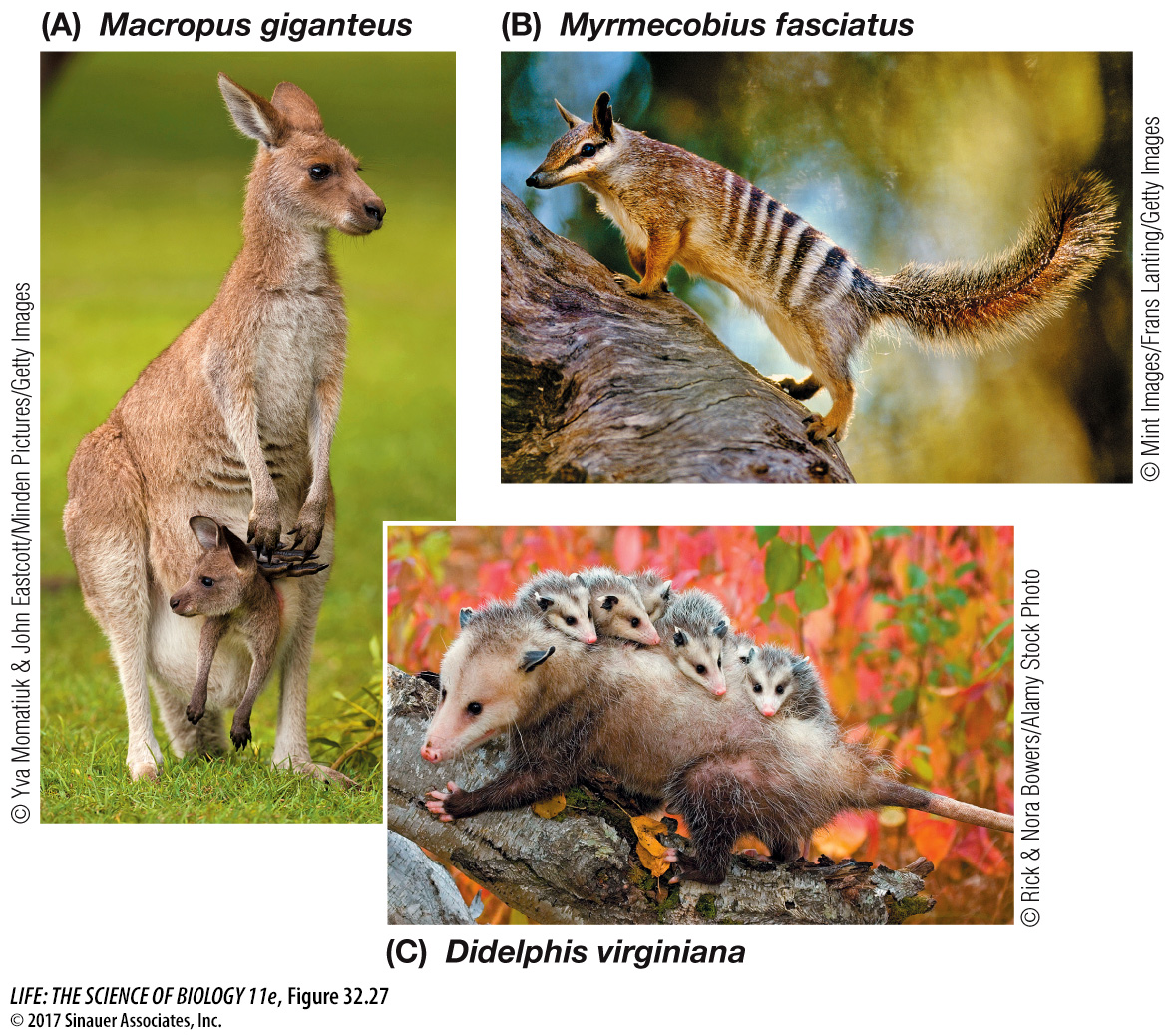
At one time marsupials were found on all continents, but the approximately 350 living species are now restricted to Australasia (Figure 32.27A and B) and the Americas (especially South America) (Figure 32.27C). Of the seven major groups of marsupials shown in Table 32.1, only the New World opossums, the shrew opossums, and the diminutive monito del monte are found in the Americas. Only one species, the Virginia opossum, is found in North America north of Mexico. Marsupials radiated to become herbivores, insectivores, and carnivores, but no marsupials live in the oceans. None can fly, although some arboreal (tree-
EUTHERIANS The majority of mammals are eutherians (“true” therians). Eutherians are sometimes called placental mammals, but this name is inappropriate because marsupials also have placentas, although they are not as well developed as in eutherians. Eutherians are more developed at birth than are marsupials; no external pouch houses them after they are born.
The more than 5,300 species of living eutherians are divided into 20 major groups (see Table 32.1). The relationships of these groups to one another have been difficult to determine because most of the major groups diverged within a short time during an explosive adaptive radiation. Modern genomic analyses have elucidated these relationships, however (Figure 32.28). These studies have revealed that the major early splits in eutherian lineages are closely associated with the breakup of the continents during the Mesozoic (see Figure 24.14), after which the major groups of mammals radiated independently in Laurasia, Africa, and South America. The reconnection of South America and North America via the Panamanian land bridge about 3 million years ago resulted in a huge faunal exchange between those continents, which is particularly evident among the mammals. South American groups such as armadillos moved north into North America, and Laurasian groups such as carnivores and odd-
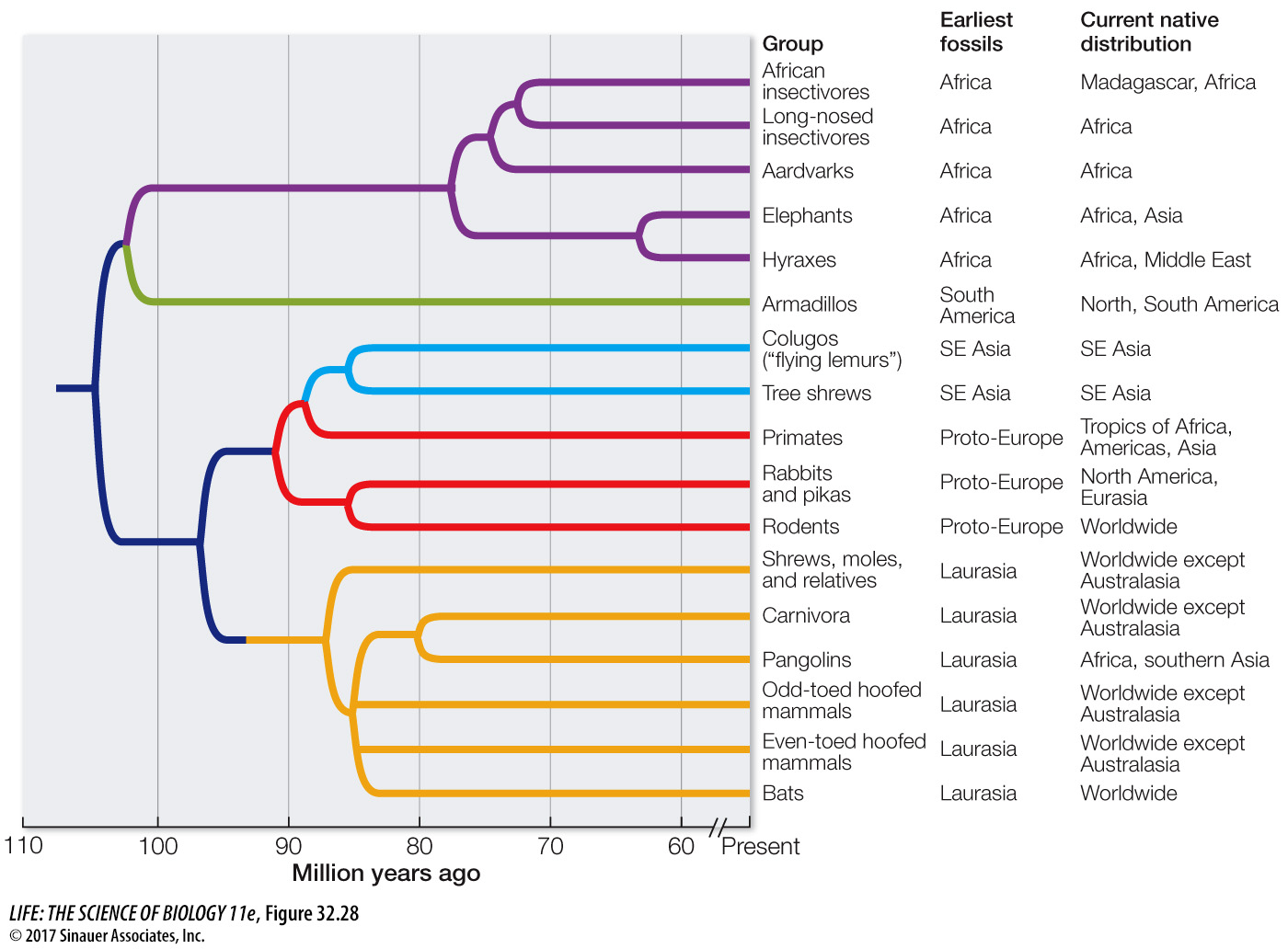
Eutherians are extremely varied in their form and ecology (Figure 32.29). The extinction of the non-
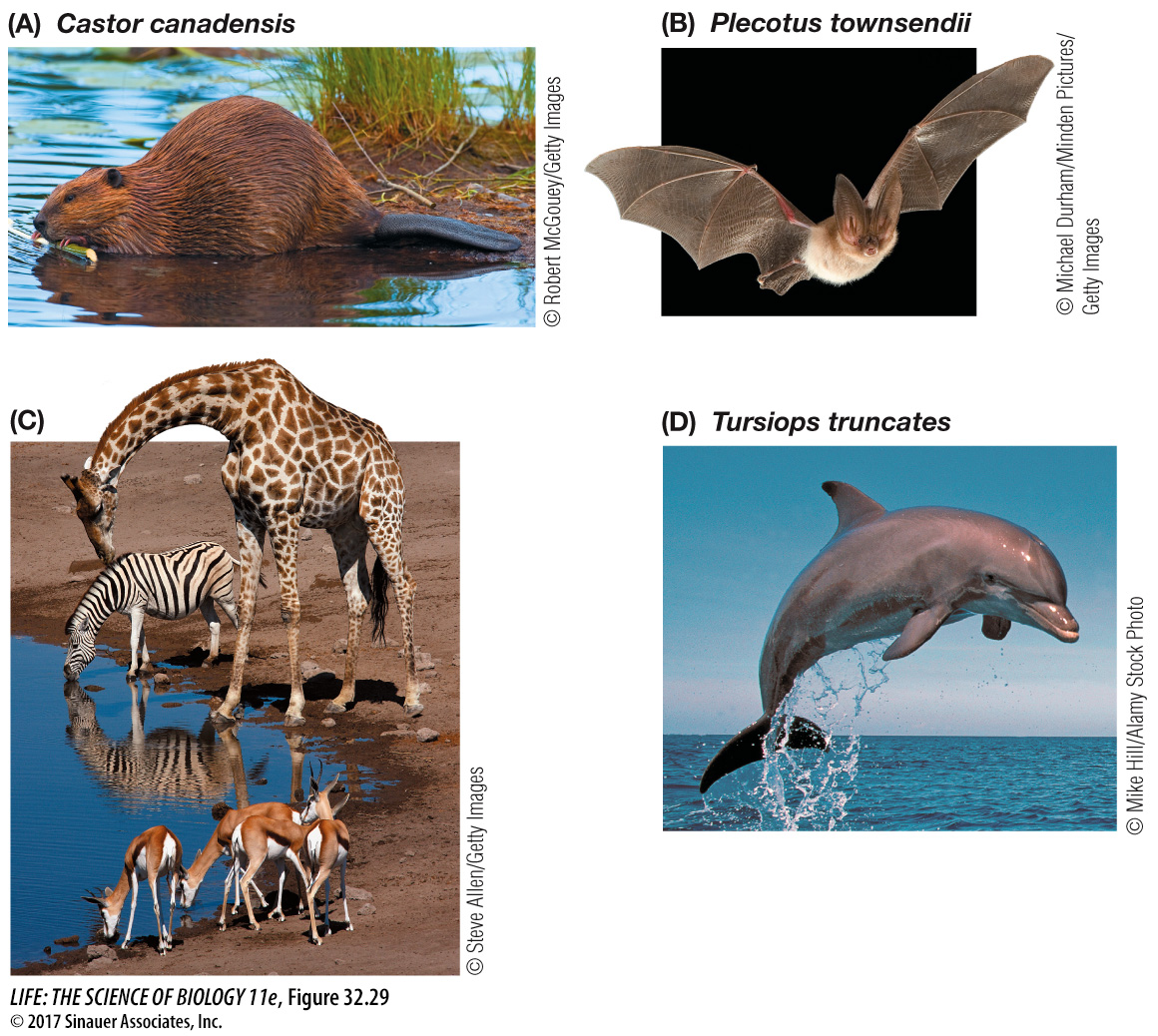
The two most diverse groups of eutherians are the rodents and the bats, which together account for about two-
Media Clip 32.7 Bats Feeding in Flight
Grazing and browsing by members of several eutherian groups helped transform the terrestrial landscape. Herds of grazing herbivores fed on open grasslands, whereas browsers fed on shrubs and trees. The effects of these herbivores on plant life favored the evolution of the spines, tough leaves, and difficult-
Several lineages of terrestrial eutherians subsequently returned to the aquatic environments their ancestors had left behind (see Figure 32.29D). The completely aquatic cetaceans—